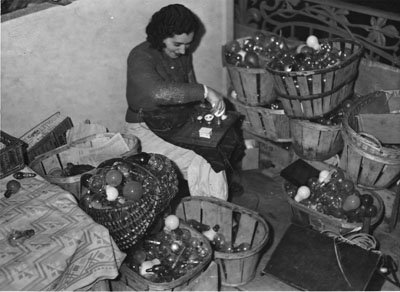Retour sur les lieux
dal 17/4/2007 al 2/6/2007
Segnalato da
17/4/2007
Retour sur les lieux
Passage du Desir, Paris
The Looting of Jewish property in Paris

The Looting of Jewish property in Paris
Curated by: Sarah Gensburger with the participation of Michele Cohen
From 18 April to 3 June 2007, the Passage du Désir will propose a unique experience to its visitors: an exhibition whose subject is the exhibition venue itself, a moment of its history.
For the building located on 85/87 rue du Faubourg St Martin, in Paris' 10th arrondissement, which now houses the Passage du Désir exhibition centre as well as the BETC Euro RSCG advertising agency, had a special destiny during the last war. Between July 1943 and August 1944, the former "Lévitan" department store building "Aryanized" by the Nazis was used as a labour camp whose inmates, picked from the internees in the camp at Drancy, were forced to sort, repair and pack the furniture and objects looted by the Nazis from the apartments of Jewish families in Paris.
In 2004, a small album of photos was identified in the German federal archives in Coblenz: probably taken by a German soldier for propaganda reasons, in order to show the efficiency of the looting operations, and reconstituted after the libertation of France by Americain soldiers responsable for the restitution of pillaged artworks, these 85 photos show all the places where the objects belonging to Jews were transported, stored and warehoused: Palais de Tokyo, Musée du Louvre, a mansion on the rue Bassano, the Gare du Nord, the Entrepôts et Magasins Généraux d'Aubervilliers. But most of these photos were taken in the Lévitan building.
They show the arrival of crates in removal lorries, the piles of objects, the accumulations of different types of china, clothing, toys. We can see the detainees at work, stacking, classifying, repairing. It becomes clear that what is referred to as the "looting of Jewish property" did not just concern works of art and valuable paintings but also modest objects of daily life - shoes, light bulbs, saucepans, sheets. We can see Nazi worthies come to inspect the building and pick out objects for themselves, as if in an ideal shop where the finest pieces of furniture are tastefully displayed to catch the shopper's eye.
We felt that it is important that these photos be exhibited in the very place where they were taken. A kind of divine justice, this return to the starting point, a "retour sur les lieux".
To express this "return", the 85 photos of the Coblenz album, divided into many chapters, are projected on the very walls of the building, by nine projectors. They are projected in a large format; life-size, at visitors' eye-level. The photos are black and white, obviously, and the room is very dark. The only visible colour is on the floor, where visitors walk over an 8x11 metre mat of a reproduction of the Parisian metro of the era, thus situating the different places around Paris where the looting took place. In the second 'cupola' room, 14 framed archive photos are hung on the pock-marked, paint-stained walls, untouched since that time. Beside each of these early images is a photo taken by Olivier Amsellem at the exactly the same spot, at exactly the same angle, but today. "Memory places and traces" is the theme of this room.
The exhibition design is by Dominique Breemersch, who has accompanied James Turrell on many projects.
The unexpected encounter between what the Lévitan building has become today: a place dedicated to modernity - avant-garde events, fashion, advertising, music, design - and its very dark past, now recognised, recalled and respected, is not the least interest of this exhibition: it also unveils in concrete fashion to the neighbourhood what had been so carefully concealed from it - or what it had not been able to or wanted to see - during these years. And it raises fascinating questions for the historian about the role of images, and in particular how they are used, depending on whether one is a German soldier taking proof of his booty, an American soldier charged with restituting stolen Jewish property, an historian, a former inmate, or a simple visitor of today, horrified to discover that all this did indeed take place.
Press Contact:
Miranda Salt, Communications Director
miranda.salt@passagedudesir.com
Passage du Desir
85-87, rue du Faubourg Saint-Martin - Paris



